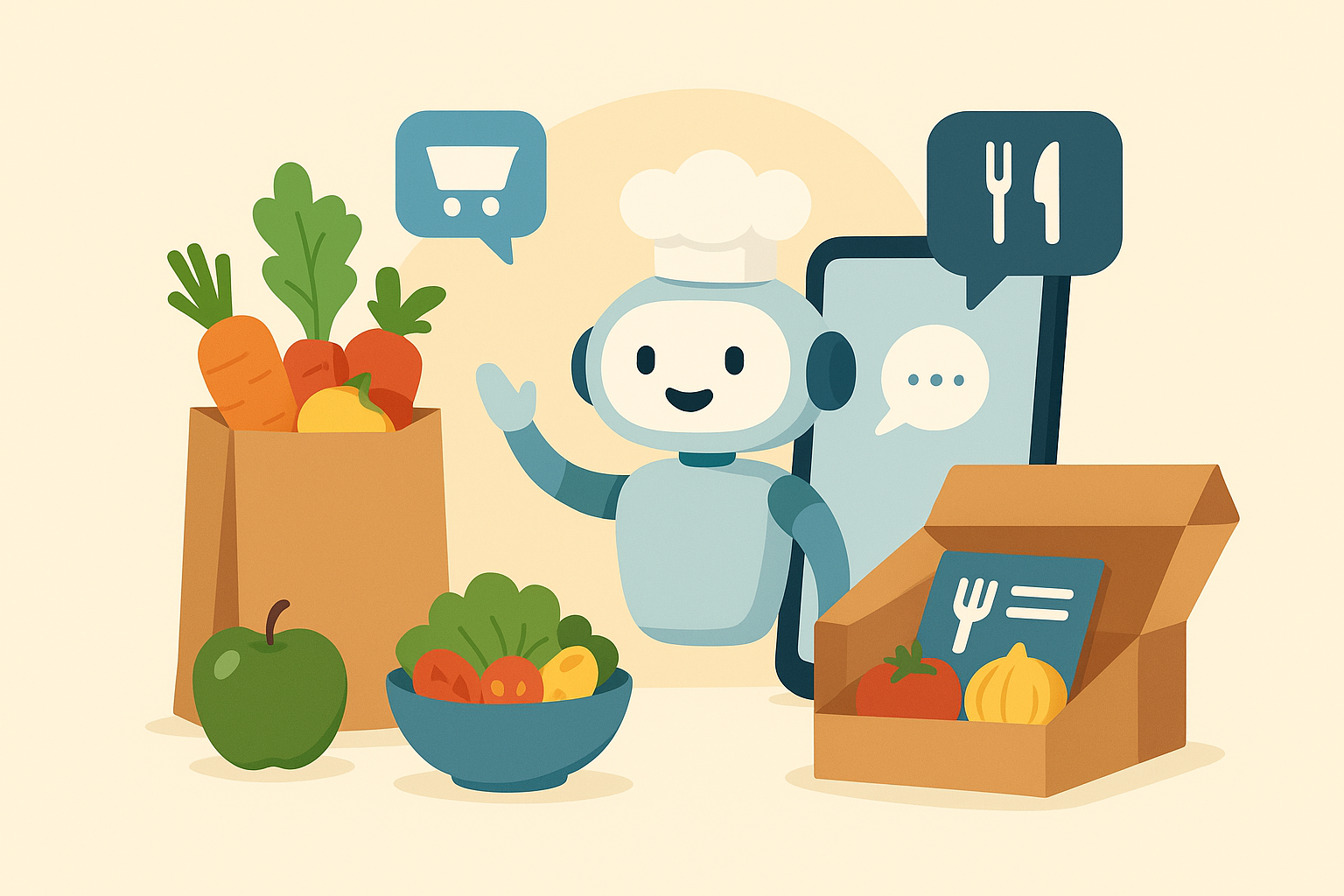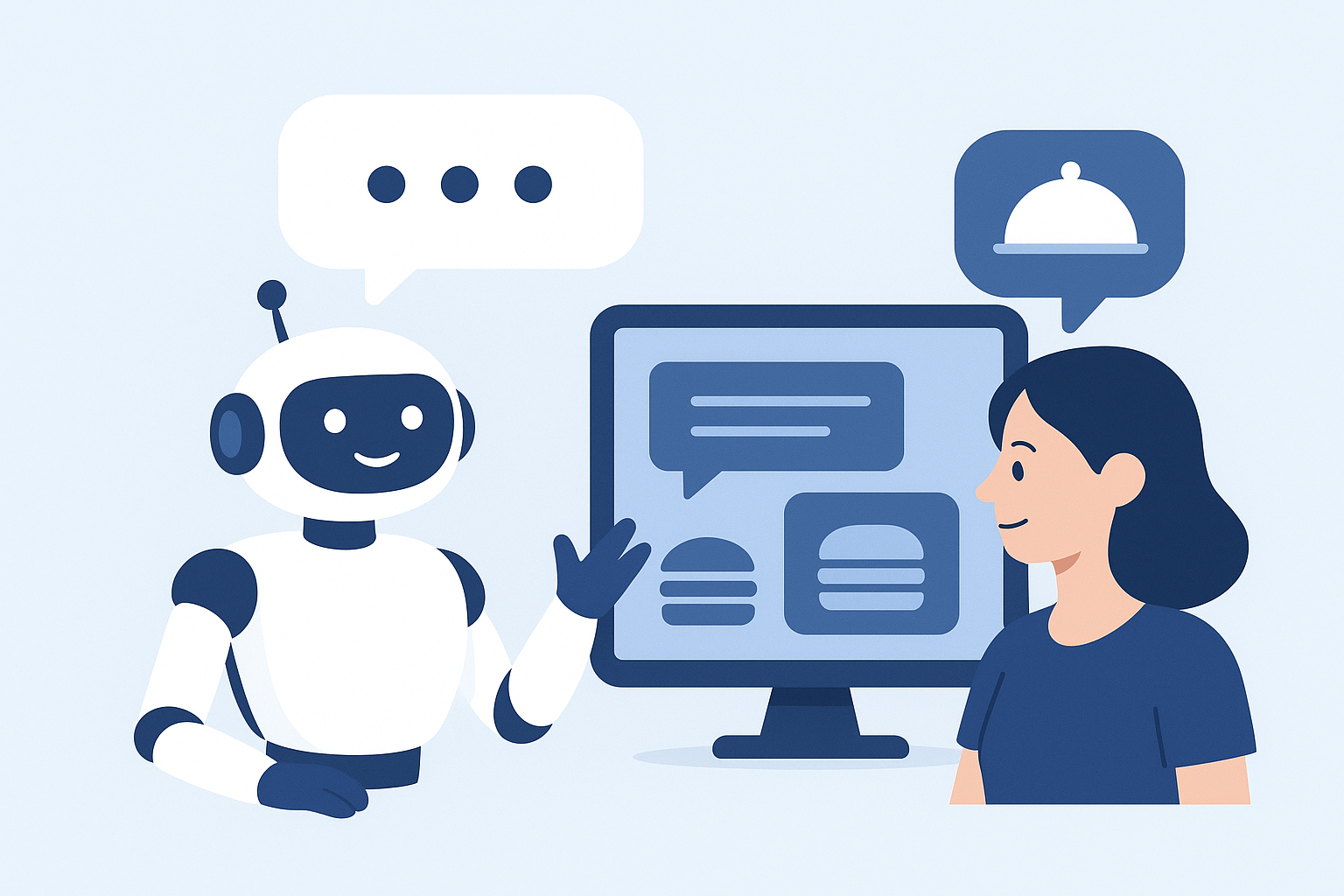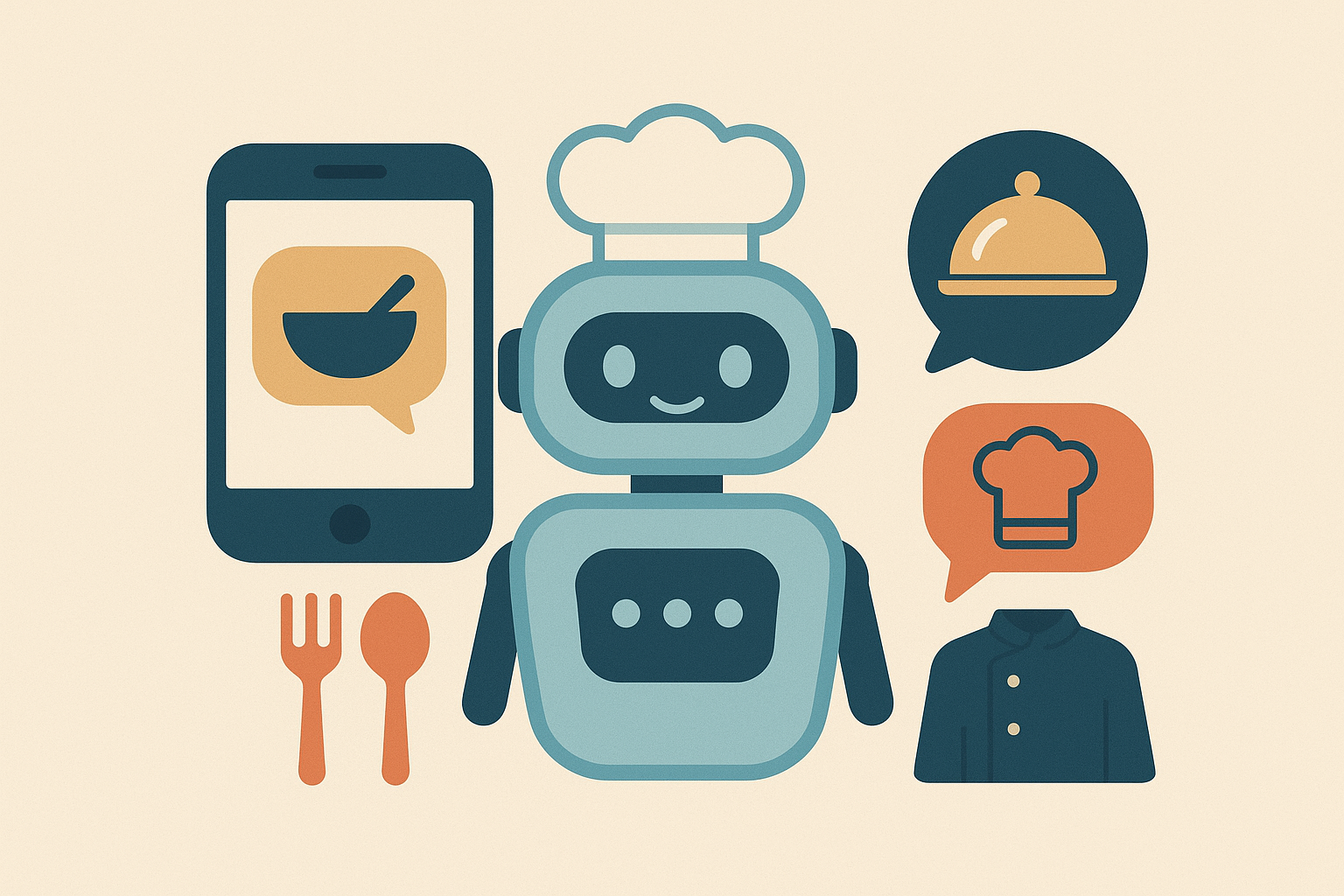The digital transformation of the food and beverage industry has introduced innovative tools that are reshaping how businesses connect with their customers. Among these advancements, the Food Chatbot stands out as a revolutionary technology that enhances customer engagement, simplifies food ordering, offers personalized recommendations, and ensures 24/7 service availability. With artificial intelligence and natural language processing, food chatbots are not only improving convenience for customers but also helping food businesses scale operations, reduce costs, and build stronger customer loyalty.
Introduction
The global food and beverage industry has always thrived on customer satisfaction, convenience, and innovation. In today’s digital-first world, where mobile apps, online platforms, and social media dominate the customer journey, businesses in this sector are under constant pressure to provide quick, seamless, and engaging experiences. This is precisely where Food Chatbots have become game-changers. By integrating artificial intelligence and conversational design, food chatbots act as intelligent assistants capable of handling inquiries, taking orders, recommending meals, and even providing nutritional advice.
For customers, this means a smooth, interactive, and personalized experience where they no longer need to wait in long queues, navigate complex websites, or deal with frustrating customer service delays. For businesses, food chatbots provide a cost-effective solution to improve engagement, increase sales, and ensure customer retention. Platforms like Engagerbot showcase how deploying AI-driven conversational tools can transform the way food businesses connect with their audiences, proving that automation can coexist with personalization in the culinary world.
The Evolution of Food Chatbots in the Digital Era
The journey of food chatbots is deeply tied to the overall evolution of artificial intelligence in customer service. Initially, chatbots were simple rule-based systems capable of answering only predefined questions. These early models were rigid, lacked personalization, and often frustrated users due to their limited understanding of natural language. However, as AI and natural language processing advanced, food chatbots became more intelligent, adaptive, and conversational.
In the food industry, the first wave of digital transformation came with the rise of food delivery apps, which disrupted traditional dining models. Customers quickly got used to ordering meals online, but they still faced challenges such as browsing through endless menus, waiting for customer support, or not finding personalized suggestions. This created a demand for a more efficient, conversational, and human-like interface. Food chatbots stepped in to meet this need, allowing customers to simply type or speak their requests and receive instant assistance.
Over time, these chatbots have gone beyond basic order-taking. Today, they can recommend meals based on previous orders, provide estimated delivery times, handle complaints, and even offer health-based food suggestions. With integrations into social media platforms, food chatbots have become more accessible, meeting customers where they already spend most of their time. This transformation represents a milestone in how food businesses operate, shifting from static websites and apps to dynamic, interactive AI-driven conversations.
Why the Food Industry Needs Chatbots More Than Ever
The food industry is one of the most competitive sectors in the global economy, and businesses are under constant pressure to deliver exceptional customer experiences. In this environment, Food Chatbots are not just optional add-ons—they are necessities. Customers today expect instant service, whether they are hungry late at night, browsing new meal options, or seeking nutritional advice. If a restaurant or delivery service cannot respond quickly, customers will likely switch to a competitor.
Food chatbots solve this problem by providing 24/7 availability and instant responses. They reduce the workload of human staff, who would otherwise spend significant time answering repetitive queries about menus, pricing, or delivery times. By automating these tasks, chatbots free up staff to focus on higher-value interactions, such as in-person dining experiences.
Additionally, food businesses often struggle with abandoned carts on their online platforms. A chatbot can intervene at the right moment, offering discounts, reminders, or alternative options to ensure the order is completed. Beyond convenience, chatbots also collect valuable data on customer preferences, which businesses can use to improve their services and marketing strategies.
In today’s highly digitalized world, where customer patience is shorter than ever, food businesses without chatbot technology risk falling behind. By implementing food chatbots, companies can ensure they stay relevant, competitive, and capable of meeting the evolving expectations of their customers.
Enhancing Customer Engagement Through AI Conversations
Customer engagement is the foundation of success in the food and beverage industry, and Food Chatbots have revolutionized this aspect by providing interactive, real-time communication. Unlike static websites or traditional customer service systems, chatbots can create personalized conversations that make customers feel valued. Instead of simply presenting a menu, a chatbot can ask questions such as “What are you in the mood for today?” or “Would you like to try something similar to your last order?” This creates a conversational journey that feels intuitive and engaging.
Food chatbots can also integrate with loyalty programs, offering personalized rewards and suggestions that encourage repeat business. For example, a chatbot can remind a customer about their accumulated loyalty points or recommend a new seasonal dish that matches their preferences. By maintaining ongoing interaction, chatbots help businesses build lasting relationships with their customers.
The ability of food chatbots to engage across multiple platforms—including websites, mobile apps, and social media—further enhances their value. Customers can order food through a messaging app they already use daily, making the process seamless and convenient. This level of engagement not only improves customer satisfaction but also boosts retention rates, ensuring that customers return to the same brand again and again.
Personalization in Food Choices with Chatbots
Personalization is one of the most powerful tools for building strong customer relationships, and food chatbots excel in this area. By analyzing customer data such as past orders, favorite cuisines, and even dietary restrictions, chatbots can provide highly customized suggestions. Instead of overwhelming a customer with dozens of menu items, a chatbot can recommend a curated selection tailored to their preferences.
For instance, if a customer frequently orders vegetarian meals, the chatbot can prioritize showing plant-based dishes or alert them to new vegan options on the menu. Similarly, for customers with allergies or health concerns, chatbots can filter out unsuitable items and recommend alternatives. This kind of personalization makes the customer feel understood and valued, which is essential for building trust and loyalty.
Beyond individual preferences, chatbots can also provide group ordering solutions. When multiple people are ordering together, the chatbot can collect everyone’s preferences and suggest a combination of dishes that satisfies the entire group. This feature is particularly valuable for office catering or family dining experiences.
In today’s food industry, where choices are abundant and competition is fierce, personalization is the key differentiator. Food chatbots ensure that customers receive recommendations that align with their unique tastes, making the dining experience enjoyable and stress-free.
Role of Food Chatbots in Online Ordering and Delivery
The rise of online ordering and food delivery services has transformed the culinary industry, and food chatbots play a crucial role in making this process smoother and more efficient. Traditionally, customers had to navigate through lengthy menus on websites or apps, which could be time-consuming and frustrating. Chatbots eliminate these barriers by allowing customers to place orders through simple, conversational interactions.
With food chatbots, customers can type or speak their desired meal, customize their order, and confirm payment—all within a few minutes. These chatbots can integrate directly with payment gateways, ensuring a seamless transaction process. Additionally, they can provide real-time updates on order status, estimated delivery times, and even track the delivery agent’s location.
Food delivery companies also benefit from reduced operational costs, as chatbots can handle a large volume of orders simultaneously without requiring additional staff. They can also reduce human error in taking orders, ensuring that customers receive exactly what they requested.
By simplifying the ordering and delivery process, food chatbots improve customer satisfaction, increase order completion rates, and enhance the overall dining experience. For businesses, this translates into higher revenues and stronger customer loyalty.
Food Chatbots for Restaurants and Cafés
Restaurants and cafés are among the biggest beneficiaries of food chatbot technology. In a traditional dining setup, customers often face long waiting times for reservations, order placement, or simple queries. With chatbots, these interactions become instant and efficient. Customers can make reservations, view menus, and even pre-order their meals through a chatbot before arriving at the restaurant.
For cafés, chatbots can handle frequent queries about opening hours, Wi-Fi availability, or daily specials. They can also manage loyalty programs by keeping track of points and offering rewards directly through the chatbot interface. This not only improves the customer experience but also reduces the workload of in-house staff, allowing them to focus on serving customers in person.
Restaurants can also use chatbots for marketing campaigns. For instance, they can notify customers about seasonal dishes, special discounts, or events through personalized chatbot messages. This level of engagement ensures that customers stay connected with the brand even when they are not dining in.
By integrating food chatbots into their operations, restaurants and cafés can improve efficiency, reduce costs, and enhance customer satisfaction, all while staying ahead in a highly competitive industry.
Food Chatbots for Grocery and Meal Kit Businesses

The role of food chatbots is not limited to restaurants and delivery services—they are also transforming grocery stores and meal kit businesses. For grocery retailers, chatbots can help customers find products, suggest recipes based on available items, and assist with online checkout. They can even provide personalized shopping lists based on previous purchases, making the grocery shopping experience faster and more convenient.
Meal kit businesses, which provide pre-packaged ingredients and recipes for customers to cook at home, also benefit greatly from chatbot integration. Chatbots can recommend meal kits based on dietary preferences, portion sizes, or cooking times. They can answer customer questions about ingredients, provide cooking tips, and send reminders about upcoming deliveries.
By offering this level of convenience and personalization, grocery and meal kit businesses can differentiate themselves in a crowded market. Food chatbots help them build stronger customer relationships by ensuring that shopping and cooking become enjoyable, hassle-free experiences.
How Food Chatbots Improve Customer Service Efficiency
Customer service is one of the most resource-intensive areas for any business, and the food industry is no exception. Traditional customer service teams often spend significant time answering repetitive questions about menus, delivery times, or order statuses. This not only delays response times but also increases operational costs.
Food chatbots streamline this process by handling routine queries instantly and accurately. They can provide customers with menu details, confirm reservations, track deliveries, and resolve common complaints without human intervention. For more complex issues, chatbots can seamlessly escalate the conversation to a human agent, ensuring that customers always get the help they need.
By reducing the workload on customer service teams, food chatbots improve overall efficiency and allow staff to focus on resolving high-priority issues. This balance between automation and human support creates a smoother, more satisfying customer experience.
For businesses, the benefits go beyond efficiency. Faster response times and accurate information lead to higher customer satisfaction, increased loyalty, and improved brand reputation. In today’s competitive market, these advantages are crucial for long-term success.
Boosting Sales and Revenue with Food Chatbots
One of the most significant advantages of food chatbots is their ability to drive sales and increase revenue. By engaging customers in personalized conversations, chatbots can upsell and cross-sell effectively. For example, if a customer orders a pizza, the chatbot can suggest adding a side dish or dessert to complement the meal.
Chatbots can also encourage repeat purchases by sending timely reminders or personalized offers. They can re-engage customers who abandoned their carts, offering discounts or incentives to complete the order. This proactive approach helps businesses recover lost sales and maximize revenue.
Additionally, chatbots can promote seasonal dishes, limited-time offers, and loyalty programs, keeping customers engaged and motivated to spend more. Their ability to analyze customer data also means they can recommend products that align with individual preferences, increasing the likelihood of purchase.
For businesses in the food industry, where profit margins are often slim, the revenue-boosting potential of chatbots is invaluable. By combining personalization with intelligent sales strategies, food chatbots ensure that businesses not only retain customers but also increase their average order value.
AI-Powered Food Recommendations and Nutrition Guidance
As health and wellness become increasingly important to customers, food chatbots are evolving to provide more than just ordering services. They now offer personalized food recommendations and nutrition guidance. By analyzing customer preferences and dietary needs, chatbots can suggest meals that align with health goals, such as weight loss, muscle gain, or managing specific conditions like diabetes.
Chatbots can also provide detailed nutritional information about menu items, including calorie counts, macronutrient breakdowns, and allergen details. This level of transparency helps customers make informed decisions about what they eat.
For businesses, offering this feature adds significant value to the customer experience. It positions them as caring brands that prioritize customer health and well-being. This can create a strong emotional connection between the brand and its customers, fostering long-term loyalty.
The integration of AI-powered recommendations and nutrition guidance shows how food chatbots are not just transactional tools but also valuable lifestyle companions. They empower customers to enjoy delicious meals while staying aligned with their health and wellness goals.
Food Chatbots and Social Media Integration
Social media has become a central hub for customer interactions, and food chatbots are increasingly integrated into these platforms to enhance engagement. Customers spend significant time on apps like Facebook, Instagram, and WhatsApp, making them ideal platforms for chatbot interactions.
By integrating with social media, food chatbots allow customers to order meals, make reservations, or ask questions directly through the platforms they already use daily. This eliminates the need for separate apps or websites, creating a seamless experience.
Food brands can also use chatbots on social media for marketing purposes. For example, they can launch interactive campaigns where customers engage with the chatbot to discover new menu items, participate in contests, or redeem special offers. This creates a fun, engaging experience that strengthens the brand’s online presence.
Social media integration ensures that food chatbots are not just tools for convenience but also powerful marketing assets. They help businesses reach a wider audience, increase brand visibility, and create meaningful connections with their customers in the digital space.
Overcoming Challenges in Food Chatbot Development
While food chatbots offer numerous benefits, their development and implementation come with challenges. One of the primary issues is ensuring that chatbots understand natural language effectively. Misunderstandings or incorrect responses can frustrate customers and damage the brand’s reputation. To overcome this, developers must invest in advanced natural language processing and continuous training of chatbot systems.
Another challenge is integration with existing systems such as point-of-sale software, payment gateways, and delivery tracking platforms. Without seamless integration, the chatbot may fail to provide accurate or timely information, leading to poor customer experiences.
Data privacy is also a major concern, as chatbots often handle sensitive information such as payment details and personal preferences. Ensuring compliance with data protection regulations is essential to maintain customer trust.
Despite these challenges, the benefits of food chatbots far outweigh the drawbacks. With careful planning, investment in technology, and ongoing improvements, businesses can successfully implement chatbots that deliver exceptional value to both customers and companies.
Data Security and Privacy in Food Chatbot Interactions
Data security and privacy are critical considerations for any digital solution, and food chatbots are no exception. As these chatbots handle sensitive customer information—such as contact details, payment information, and dietary preferences—businesses must ensure that the data is protected from breaches and misuse.
Implementing robust encryption methods, secure payment gateways, and strict authentication protocols are essential steps in safeguarding customer data. Businesses must also comply with data protection regulations such as GDPR or CCPA, depending on their region. Transparency is equally important; customers should be informed about how their data is collected, stored, and used.
Food chatbots can also be programmed to minimize the storage of sensitive data, reducing the risk of long-term exposure. For example, payment details can be processed securely without being saved permanently. By prioritizing security and privacy, businesses not only protect their customers but also build trust and credibility.
In a world where data breaches are increasingly common, ensuring the safety of customer interactions through chatbots is not just a technical requirement but a critical factor in brand reputation and long-term success.
Future Trends of Food Chatbots in the Culinary World
The future of food chatbots looks incredibly promising as technology continues to advance. One emerging trend is the integration of augmented reality (AR) and virtual reality (VR) with chatbots, allowing customers to visualize their meals before ordering. This immersive experience can significantly enhance decision-making and satisfaction.
Another trend is the rise of multilingual chatbots, which can communicate with customers in their preferred language. This is particularly valuable for global food brands aiming to serve diverse customer bases.
Voice-activated chatbots are also becoming more popular, offering hands-free experiences that are convenient for busy customers. Integration with smart home devices such as Amazon Alexa or Google Home will further expand the role of food chatbots in everyday life.
As AI becomes more advanced, chatbots will not only handle transactions but also provide emotional intelligence, recognizing customer moods and adjusting responses accordingly. This human-like interaction will make chatbots even more engaging and effective in building customer relationships.
Voice-Enabled Food Chatbots for Hands-Free Experiences
Voice technology is rapidly gaining popularity, and food chatbots are at the forefront of this trend. By enabling voice commands, chatbots allow customers to place orders, ask questions, or track deliveries without typing. This is particularly convenient for customers who are multitasking, such as cooking at home or driving.
Voice-enabled food chatbots also provide accessibility for customers with disabilities, ensuring that everyone can enjoy a seamless dining experience. By integrating with smart speakers and voice assistants, these chatbots become even more versatile and widely accessible.
For businesses, adopting voice technology offers a competitive edge. It not only enhances customer convenience but also aligns with the growing demand for hands-free, efficient solutions. As voice recognition technology continues to improve, voice-enabled food chatbots will become a standard feature in the food industry.
Impact of Food Chatbots on Customer Loyalty Programs
Loyalty programs are a key strategy for retaining customers in the food industry, and food chatbots can significantly enhance their effectiveness. Instead of relying on physical cards or separate apps, customers can access loyalty rewards directly through the chatbot.
Chatbots can track points automatically, remind customers about unused rewards, and suggest ways to redeem them. They can also provide personalized offers based on customer preferences, increasing the likelihood of repeat purchases.
By making loyalty programs more accessible and engaging, chatbots encourage customers to stay connected with the brand. This not only increases customer lifetime value but also strengthens the emotional bond between the brand and its customers.
In today’s competitive market, where customers have countless options, loyalty programs powered by chatbots provide a unique advantage that helps businesses stand out and retain their customer base.
Case Studies: Successful Food Brands Using Chatbots

Several leading food brands have successfully implemented chatbots, demonstrating their effectiveness in real-world scenarios. For example, Domino’s Pizza introduced a chatbot that allows customers to order directly through messaging apps. This innovation simplified the ordering process and increased customer engagement.
Similarly, Starbucks developed a chatbot that enables customers to place orders and make payments through voice or text commands. This streamlined approach enhanced customer convenience and boosted sales.
Grocery chains have also adopted chatbots to assist customers with shopping lists, recipe suggestions, and online checkout. These implementations highlight how versatile and impactful food chatbots can be across different sectors of the food industry.
These case studies prove that food chatbots are not just theoretical tools but practical solutions that drive measurable results. By learning from these success stories, other businesses can implement chatbot strategies tailored to their unique needs and customer base.
Conclusion
The rise of Food Chatbots represents a significant milestone in the digital transformation of the culinary world. By combining artificial intelligence with conversational design, these chatbots provide seamless, personalized, and efficient customer experiences. From simplifying online ordering and delivery to offering personalized food recommendations and nutrition guidance, food chatbots are revolutionizing the way businesses interact with their customers.
For businesses, the benefits extend beyond convenience. Food chatbots reduce operational costs, boost sales, improve customer loyalty, and ensure data-driven decision-making. As technology continues to evolve, the role of chatbots will only expand, becoming integral to every aspect of the food industry.
Platforms like Engagerbot demonstrate the immense potential of chatbot technology in helping businesses stay competitive, innovative, and customer-focused. The future of the food industry lies in embracing digital solutions that not only meet but exceed customer expectations—and food chatbots are at the heart of this transformation.

